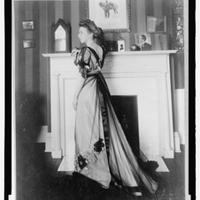Browse Exhibits (1 total)
Women and Dress: Women's Contributions To WWI Efforts In Connecticut

Although the United States did not enter the World War I until 1917, a year before the war ended, great numbers of women stepped up to “Do their Part” supporting their male counterparts. Women from all social classes utilized their intellectual and physical strengths and actively participated in wartime efforts. The absence of males working in business, manufacture, agriculture and homes meant that women had to take their place to maintain a strong economy.
The turn of the century in the United States ushered in many changes including the way in which women were perceived by males. Reformist movements drove changes in fashion and attitude towards women’s mental capabilities and physical appearance. Dress Reform pushed for changes in women’s dress to eliminate the physically constricting corset and layers of fabric in women's clothing. Dress Reformers advocated spending time outdoors and participating in physical activity. Victorian dress had been designed to prevent women from moving freely or from participating in outdoor activities such as riding bicycles or playing sports. Along with drss reform new styles of underclothing clothing were coming into fashion, including Bloomers, which were very popular in America.
The outbreak of World War I, and America’s entry into the conflict resulted in greater numbers of women in the workforce and their active participation wartime activities. Women became involved in all aspects of the American economy. Their work outsied the home brought about a change in women’s spheres and helped advance dress reform and the women’s suffrage movement.
This exhibit will demonstrate how “Dress” was a means for women to contribute to the World War I wartime effort. It will focus on the women of all social classes and ages in the state of Connecticut. The intent is to illustrate the various ways in which “dress” was used by women to help fight the war.
The first part of this exhibit will focus on women's fashion in World War I. The new "war time" styles reflected rationing of textiles such as sil and wool for the solidiers. American women's fashion changed from highly detailed to simple dress using cotton instead of luxurious textiles and decorative emroidery. The new style used fewer materials and mimicked the military uniforms to serve as a symbol of unity and equality. There were changes in the style of women’s uniforms due to the physical nature of their newfound jobs as doctors, nurses, Red Cross workers and in the Army and Naval reserves.
The word “dress” is further interpreted to include women’s contributions to the wartime effort through making “dress” such as knitting, sweaters and socks and other articles of clothing for soldiers and Belgian refugees to be sent abroad. Women in WWI started making surgical “dressing” and learning to “dress” wounds in Red Cross classes for use at home and abroad.
Lastly, the window“dressings”of department stores in Hartford showcased wartime slogans and posters to encourage women to participate, contribute monetarily in war bonds and buy “comfortable shoes to participate in Red Cross parades” to express nationalist pride and unity.
CREDITS:Bridgeport Press, Dudley Collection, State of Connecticut Digital Archive,Connecticut Historical Society, Hartford Courant, Library of Congress